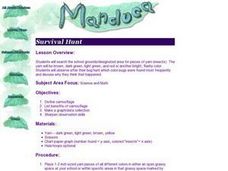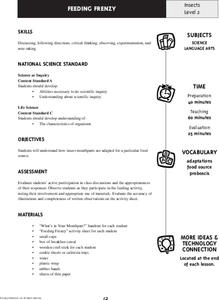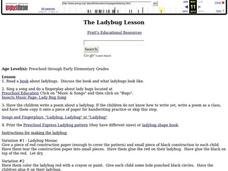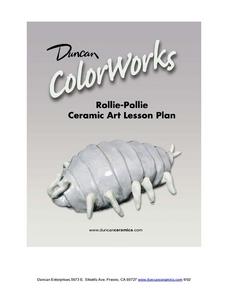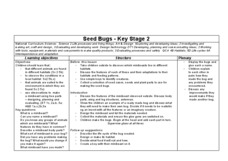Howard Hughes Medical Institute
Tracking Genetically Modified Mosquitoes
What's that buzzing in your ear? An insightful lesson about genetically modified mosquitoes! Partnered pupils explore the creation, release, and monitoring of mosquitoes designed to reduce the mosquito population. After watching a video,...
Curated OER
Survival Hunt
Young scholars search for yarn representing insects on school grounds. They discuss which colors where found more frequently and why after the experiment. They use their math skills to determine percentages.
Curated OER
Animals A to Z: Ladybug
In this ladybug learning exercise, 3rd graders will read 10 facts about a ladybug to gain an understanding of the insect's characteristics. Students will locate 10 errors of punctuation, capitalization, spelling, and grammar.
Curated OER
Megabeasts
Create larger-than-life insects for the classroom. Bugs are usually pretty small, but during the Jurassic period they were huge. Kids use diagramming and scale conversion to enlarge a modern day insect so that it is as big as its ancient...
Curated OER
I Wonder How Fast Manduca Grows Compared To Me
Students study the Manduca bug and its growth data. They look for patterns and compare their own growth rate to that of the Manduca.
Curated OER
Creepy, Crawly Critters
Students study characteristics of insects by creating models from an assortment of materials. They create rubrics showing what an insect must have and create an insect, using a bag of materials. They cut out the puzzle insects included...
Curated OER
Homeschooling Chronicles - Insects
The world of bugs may be small, but they can have a big impact on the lives of nature explorers like my children.
Curated OER
COMMON KINDS OF INSECTS
Young scholars will recognize and name three common insects.1. Share background information with students. 2. Provide young scholars with the "bug body" puzzle pages, and have them cut the puzzles out.1. Share background information with...
Curated OER
Be on the Lookout!
Pupils create "Wanted" posters for destructive bugs. They practice research skills as they learn about the characteristics, diets, habitats, and habits of a variety of bugs.
Curated OER
Build Your Own Bug
Students create a unique bug. In this lesson about bugs, students use their imagination to develop a new kind of bug. Students use construction paper, scissors, glue, and crayons to make their bug. Students explore the different parts of...
Curated OER
Insects: Bugs, Science, Entomology
In this lesson, insects are explored through reading of children's literature, classifying insects versus non-insects, drawing and painting various insects, and learning how to clap to certain rhythms while reciting insect names.
Cornell University
Field Day: Be an IPM Detective
Become a pest detective! Individually or in small groups, scholars scout the land to discover which pests—plant and animal—inhabit it, determine whether the pests are endangering the environment, and summarize their findings.
Cornell University
Weed IPM
Go on a weed hunt! Scholars gain insight into the characteristics of plants and examine the outdoor environment in order to identify five different types of weeds. Learners then show what they know with a one-page reflection.
Curated OER
Bug Matching Worksheet
In this bug identification worksheet, students draw a line from each of 10 pictures of insects to the words that name them. Note: The names begin with capital letters.
Curated OER
Bug Hunt
Students strengthen observational skills by searching for insects in their home and classroom. In this observation lesson, students use magnifying glasses to classify what kinds of bugs were found. Students then create a bar graph to...
Curated OER
Word Scramble-Bugs
In this bugs worksheet, students unscramble a total of 8 names of bugs which are accompanied by their picture. A reference web site is given for additional activities.
Curated OER
Macroinvertebrate Mix and Match
Students are introduced to macroinvertebrates (primarily insects), the major segments of aquatic insects (the head, thorax and abdomen) and also differentiate between larval, nymph and adult stages. They investigate the head, thorax and...
Curated OER
Feeding Frenzy
Students examine, through experimentation and simulation, how insect mouthparts are adapted for particular food sources, discuss how various animals have adapted to survive, play Feeding Frenzy game, and complete activity sheets.
Curated OER
The Ladybug Lesson
Students explore the traits of ladybugs. In this ladybug lesson, students read books, sing songs, and learn fingerplays about ladybugs. Students also create their own ladybugs.
Curated OER
Rollie-Pollie - - Ceramic Art
Students are introduced to a variety of sculpting techniques: rolling, pinching and scoring. They practice utilizing additive and subtractive processes in making simple sculptural forms to depict bugs. Each student also interprets...
Curated OER
Introduction To Bug Collecting
Students explore process of live collection of insects and spiders using sweep nets, aerial nets, and beating sheets. they collect, examine and release several different types of insects or spiders then compare their journal drawing of...
Curated OER
Arthropod Mouth Parts and Food
Students identify the different types of mouths arthropods have for eating various types of food. Given photographs of the different types of arthropods, students identify which mouth they have and what type of food they can eat with...
Curated OER
Seed Bugs; Stage 2
Students examine nature by participating in an environmental art activity. In this imaginary creature activity, students discuss the importance of a habitat when pertaining to wild animals or bugs. Students utilize tree parts which they...
Curated OER
Using Insects in the Classroom
Students identify and interpret the importance and diversity of the insect world. Students organize various insects into a classification system based on their characteristics. Students create tree or window ornaments utilizing their...
Other popular searches
- Insects and Bugs
- Bugs and Insects Crafts
- Bugs and Insects Art
- Insects and Bugs Stencils
- Theme Insects and Bugs
- Bugs and Insects Prue School
- Studying Bugs and Insects
- Bugs and Insects Pre School
- Bugs and Insects Worksheet
- Bugs or Insects Anatomy
- Insects, Lightning Bugs
- Bugs Insects Free



